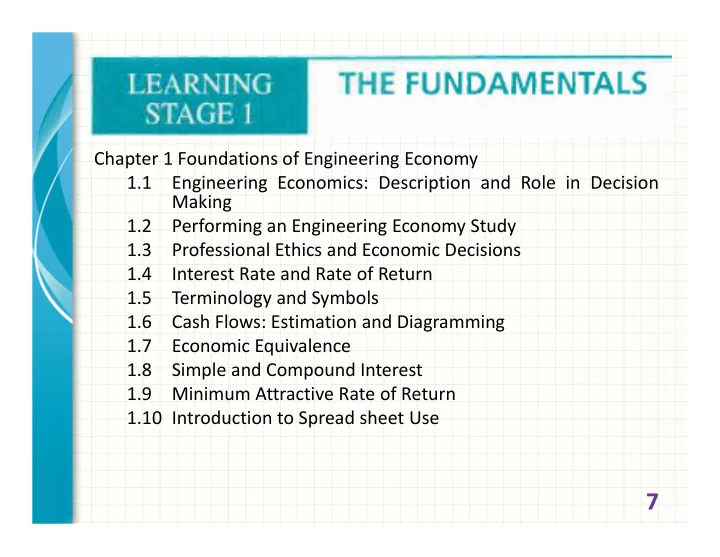

Chapter 1 Foundations of Engineering Economy 1.1 Engineering Economics: Description and Role in Decision Making 1.2 Performing an Engineering Economy Study 1.3 Professional Ethics and Economic Decisions 1.4 Interest Rate and Rate of Return 1.5 Terminology and Symbols 1.6 Cash Flows: Estimation and Diagramming 1.7 Economic Equivalence 1.8 Simple and Compound Interest 1.9 Minimum Attractive Rate of Return 1.10 Introduction to Spread sheet Use 7
Chapter 2 Factors: How Time and Interest Affect Money Progressive Example-The Cement Factory Case – 2.1 Single-Amount Factors (F/P and P/F) 2.2 Uniform Series Present Worth Factor and Capital Recovery Factor (P/A and A/P) 2.3 Sinking Fund Factor and Uniform Series Compound Amount Factor (A/F and F/A) 2.4 Factor Values for Untabulated i or n Values 2.5 Arithmetic Gradient Factors (P/G and A/G) 2.6 Geometric Gradient Series Factors 2.7 Determining i or n for Known Cash Flow Values 8
Chapter 3 Combining Factors and Spread sheet Functions 3.1 Calculations for Uniform Series That Are Shifted 3.2 Calculations Involving Uniform Series and Randomly Placed Single Amounts 3.3 Calculations for Shifted Gradients 9
Chapter 4 Nominal and Effective Interest Rates Progressive Example -The Credit Card Offer Case 4.1 Nominal and Effective Interest Rate Statements 4.2 Effective Annual Interest Rates 4.3 Effective Interest Rates for Any Time Period 4.4 Equivalence Relations: Payment Period and Compounding Period 4.5 Equivalence Relations: Single Amounts with PP ≥ CP 4.6 Equivalence Relations: Series with PP ≥ CP 4.7 Equivalence Relations: Single Amounts and Series with PP < CP 4.8 Effective Interest Rate for Continuous Compounding 4.9 Interest Rates That Vary over Time 10
Chapter 5 Present Worth Analysis Progressive Example-Water for Semiconductor Manufacturing Case 5.1 Formulating Alternatives 5.2 Present Worth Analysis of Equal-Life Alternatives 5.3 Present Worth Analysis of Different-Life Alternatives 5.4 Future Worth Analysis 5.5 Capitalized Cost Analysis 11
Chapter 6 Annual Worth Analysis 6.1 Advantages and Uses of Annual Worth Analysis 6.2 Calculation of Capital Recovery and AW Values 6.3 Evaluating Alternatives by Annual Worth Analysis 6.4 AW of a Permanent Investment 6.5 Life-Cycle Cost Analysis 12
Chapter 7 Rate of Return Analysis: One Project 7.1 Interpretation of a Rate of Return Value 7.2 Rate of Return Calculation Using a PW or AW Relation 7.3 Special Considerations When Using the ROR Method 7.4 Multiple Rate of Return Values 7.5 Techniques to Remove Multiple Rates of Return 7.6 Rate of Return of a Bond Investment 13
Chapter 8 Rate of Return Analysis: Multiple Alternatives 8.1 Why Incremental Analysis Is Necessary 8.2 Calculation of Incremental Cash Flows for ROR Analysis 8.3 Interpretation of Rate of Return on the Extra Investment 8.4 Rate of Return Evaluation Using PW: Incremental and Breakeven 8.5 Rate of Return Evaluation Using AW 8.6 Incremental ROR Analysis of Multiple Alternatives 8.7 All-in-One Spread sheet Analysis (Option al) 14
Chapter 8 Rate of Return Analysis: Multiple Alternatives 8.1 Why Incremental Analysis Is Necessary 8.2 Calculation of Incremental Cash Flows for ROR Analysis 8.3 Interpretation of Rate of Return on the Extra Investment 8.4 Rate of Return Evaluation Using PW: Incremental and Breakeven 8.5 Rate of Return Evaluation Using AW 8.6 Incremental ROR Analysis of Multiple Alternatives 8.7 All-in-One Spread sheet Analysis (Option al) 15
Chapter 9 Benefit/Cost Analysis and Public Sector Economics Progressive Example-Water Treatment Facility #3 Cases 9.1 Public Sector Project 9.2 Benefit/Cost Analysis of a Single Project 9.3 Alternative Selection Using Incremental HIC Analysis 9.4 Incremental BIC Analysis of Multiple, Mutually Exclusive Alternatives 9.5 Service Sector Projects and Cost-Effectiveness Analysis 9.6 Ethical Considerations in the Public Sector 16
17
18
CHAPTER 1 Lecture slides to accompany Engineering Economy 7th edition Leland Blank Anthony Tarquin Foundations Of Engineering Economy 19
Learning Objectives �������� ���������� ��� ����������� �������� �� ����������� �������� → ���� ������� ���� ���� ���� � �� ��������� ���������� ��� ����� �� ��������� ����������� ������� ��� → ������� �� �������� ������ ��������� ��� ���� �� ����������� ������� �� ��� ��������� → ������ �������� � !���� �������� "������� ���� �� ������ �� ������������ ������� �� ����������� → ������� ������ 20
Learning Objectives #� "������� ���� ������� ������������ �$��� �������� ����� ��� ���� �� ������� → %� &���'������ ���������� ���� ����'������ ����� �� �������� ������ → (� !����� ��� �������� �������� )�������� ������ �������� ��� �������� �������� ��� ��� �� ���� → �������� �������� *� !��$��� "������� ��� ��� ����������� ������� ����������� ��� → ���$���� +� !����������� ��������� → "������� ��� &,���- ������������ ��������� �������� ���� �� ���'� ����������� ������� ���$����� 21
Learning Objectives .� /������ 0�������'� 1��� �� 1����� ���������� ��� ������� ��� ��� �� /������ 0�������'� → 1��� �� 1����� 2/0113� �4� )��� ����� ���������� ���� �����5 ����� ����������5 ��� ��� �� → ����������� ��������� ����� ��� ���$���� ���� ��� ��� ���� �� *� �� �������� � �������� �������� ���� �� → ���$�� �� ����� ��� � ������� ����� ������ �� ���$��� ��� !������������ ��'���� � ������������ ���� ��'��'�� ������ ��� → �������� ��������5 ������������� �������'��� ��������� 22
Chapter Overview &���������� ������� �� ��� ����������� �� �������� ������� � ��� �������� �� �'������ ���������'��5 ����������� ��� ���� '���� �� ������ ��� ����������� ������� ����� ��'��'�� ��������� � �������� �������� ������� �� ����� ��� ��������� ���� ����� �'�� � �������� ������ �� ����� ��� ������� �� ����'������ ����� �� ������������� ��� � ��������� ���� �� ����� �� ��������� ����� ��� ����� �� �������� ������ ��� ����������� $������ ������ �������� 2$���� �� ��������� ����3 ��� �������� �������� 2$���� ���� ��������� ��� �������� ���� ��������3 ��'� $��� ������$�� �� ��������5 ��$���5 ��� ������� ���� ����� �� ����������� �� '��� �������$��5 ���������� �'�� ���� ������� �� ����5 �� �� ��� ������ �� ���������5 ���������� ����� 23
Recommend
More recommend